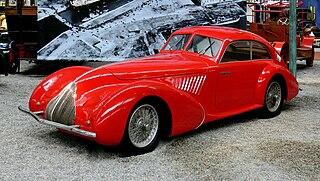
The straight-eight engine or inline-eight engine is an eight-cylinder internal combustion engine with all eight cylinders mounted in a straight line along the crankcase. The type has been produced in side-valve, IOE, overhead-valve, sleeve-valve, and overhead-cam configurations.

An overhead camshaft (OHC) engine is a piston engine where the camshaft is located in the cylinder head above the combustion chamber. This contrasts with earlier overhead valve engines (OHV), where the camshaft is located below the combustion chamber in the engine block.

In automotive engineering a multi-valve or multivalve engine is one where each cylinder has more than two valves. A multi-valve engine has better breathing and may be able to operate at higher revolutions per minute (RPM) than a two-valve engine, delivering more power.

Delage was a French luxury automobile and racecar company founded in 1905 by Louis Delage in Levallois-Perret near Paris; it was acquired by Delahaye in 1935 and ceased operation in 1953.

Aurelio Lampredi was an Italian automobile and aircraft engine designer.

Isotta Fraschini was an Italian luxury car manufacturer, also producing trucks, as well as engines for marine and aviation use. Founded in Milan, Italy, in 1900 by Cesare Isotta and the brothers Vincenzo, Antonio, and Oreste Fraschini, in 1955 it was merged with engine manufacturer Breda Motori and renamed F.A. Isotta Fraschini e Motori Breda. The company went bankrupt in 1999. In 2000, a new company was founded as a subsidiary of Fincantieri, under the name of Isotta Fraschini Milano based in Bari.

The Alfa Romeo 8C was originally a range of Alfa Romeo road, race and sports cars of the 1930s. In 2004 Alfa Romeo revived the 8C name for a V8-engined concept car which made it into production for 2007, the 8C Competizione.

Alfieri Maserati was an Italian automotive engineer, known for establishing and leading the Maserati racing car manufacturer with the other Maserati Brothers.

Lorraine-Dietrich was a French automobile and aircraft engine manufacturer from 1896 until 1935, created when railway locomotive manufacturer Société Lorraine des Anciens Etablissements de Dietrich et Cie de Lunéville branched into the manufacture of automobiles. The Franco-Prussian War divided the company's manufacturing capacity, one plant in Niederbronn-les-Bains, Alsace, the other in Lunéville, Lorraine.

The Isotta Fraschini Tipo 8A was a luxury car made by the Italian manufacturer Isotta Fraschini. It was the successor to the Tipo 8 model, with a new 7.3 litre straight-eight engine to replace the 5.9 litre unit used in the previous model. This new engine could produce 115–160 brake horsepower (86–119 kW). This was the most powerful mass-produced straight-8 engine in the world at that time. The Tipo 8A was offered only with bare chassis and engine for the coachbuilders.

The Isotta Fraschini Tipo 8 is an Italian luxury car made between 1919 and 1924.

The Isotta Fraschini Tipo 8B is an Italian luxury car made between 1931 and 1934.

The Isotta Fraschini Tipo 8C Monterosa was a prototype car, designed in secret during World War II, of which between three and six were manufactured by Isotta Fraschini.
The Isotta Fraschini T8 and T12 are Italian concept cars revealed in 1996 and 1998 respectively as an attempt by Isotta Fraschini to resurrect their prestigious luxury automotive brand name of the early 20th century.

The Isotta Fraschini Tipo FE was an early Italian race car, and the Isotta Fraschini Tipo FENC is the road version and is considered one of the earliest examples of a sports car.

The Isotta Fraschini D65 is a truck built in Italy from 1940 to 1955.

Ernest Henry was a mechanical engineer. He developed auto racing engines, and is especially well known for his work for Peugeot and Ballot, who dominated Grand Prix auto racing from 1912 to 1921. His engine design directly influenced Sunbeam Racing cars as early as 1914; the 1921 Grand Prix Sunbeams owe much to his work with Ballot and the 1922 Grand Prix Sunbeams were designed by him.

The Isotta Fraschini Tipo KM is luxury car produced between 1910-1914 in Italy. Only 50 were built. Many of those 50 examples were exported to the United States, where the company had a branch on New York's Broadway.

The Isotta Fraschini Zeta was an air cooled X engine with 24 cylinders developed by the Italian engineering company Isotta Fraschini in the 1940s. It was developed as an indigenous alternative to the imported Daimler-Benz DB 605 that was being built under licence as the Fiat RA.1050 R.C.58 Tifone. The engine was essentially two Gamma V12 engines on a single crankshaft, but proved troublesome to develop and never entered production.
The Isotta Fraschini Beta was an air cooled aircraft engine produced by the Italian engineering company Isotta Fraschini in the 1940s.
This page is based on this
Wikipedia article Text is available under the
CC BY-SA 4.0 license; additional terms may apply.
Images, videos and audio are available under their respective licenses.

















